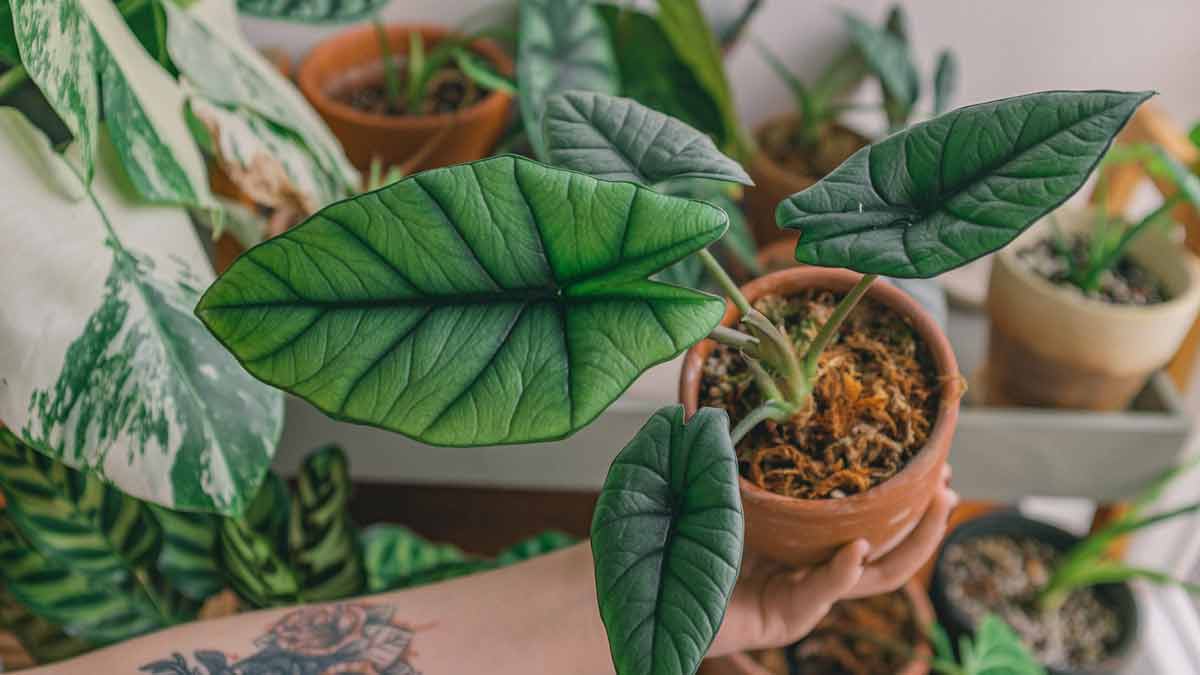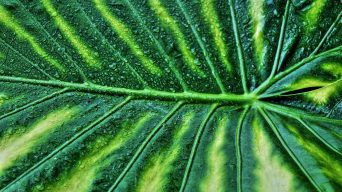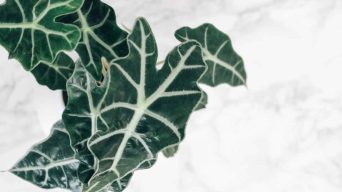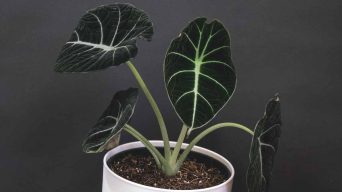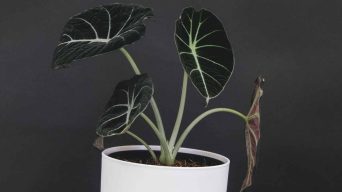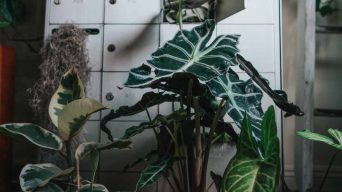To care for an Alocasia plant, water it weekly and mist frequently to keep the soil moist but not wet. During winter, let the top 2 inches of soil dry out between waterings to avoid root rot. Avoid overwatering as they are sensitive to soggy soil. Water until 25-50% of the soil volume is dry, discard any excess water.
With their stunning foliage and unique appearance, Alocasia plants are a popular choice among indoor plant enthusiasts.
However, finding the perfect balance in watering these tropical beauties can be tricky.
In this easy guide, we’ll discuss essential factors that affect your Alocasia’s watering needs and tips to help you avoid underwatering and overwatering.
By understanding the signs of improper watering and implementing the suggestions provided here, you can ensure your Alocasia thrives for years.
Factors Affecting Alocasia Plant Watering Needs
Paying close attention to its watering needs is essential to keep your Alocasia plant thriving and healthy.
However, determining the ideal watering frequency can be challenging, as several factors can affect this crucial aspect of plant care.
From the climate and humidity levels to the plant’s size and age, various elements play a role in deciding how often to water your Alocasia.
Below we’ll explore the factors that impact Alocasia plant watering requirements, helping you develop a successful watering routine for your beloved plant.
Climate And Humidity
Climate and humidity play a significant role in determining the ideal watering frequency for Alocasia plants.
These tropical plants thrive in environments with high humidity, affecting how quickly the soil dries out.
If your home is more humid during summer or uses a humidifier indoors, your Alocasia plant may not require as much supplemental water as homes in arid regions where indoor air is significantly drier.
It’s essential to monitor your plant closely while considering regional climate and indoor humidity when determining how often to water it.
Soil Type And Quality
The soil type and quality are crucial in determining how often to water Alocasia plants.
Choosing a well-draining, well-aerated potting soil mix is essential for these tropical plants, as it allows excess water to drain from the root system, preventing issues like root rot and fungal infections.
It is essential to note that different Alocasia varieties may have slightly varying preferences regarding soil types.
For example, jewel Alocasias such as Black Velvet (Alocasia reginula) and Dragon Scale (Alocasia cuprea) prefer more airy potting mixes compared to other varieties like African Mask Plant (Alocasia amazonica).
Regularly assessing the condition of your plant’s soil will help you determine if adjustments in watering frequency are required.
Size And Age Of The Plant
The size and age of your Alocasia plant play a significant role in determining its watering needs.
Younger and smaller plants generally require more frequent watering, as they are still establishing their root systems and need consistent moisture to encourage healthy growth.
As the plant matures and grows, it develops a more robust root system to store water efficiently.
As a result, older or more established Alocasias like the striking Alocasia zebrina or eye-catching Alocasia amazonica can typically go longer between watering sessions.
In these cases, you might only need to water once every 7-10 days, depending on other factors such as humidity levels or potting soil type.
Pot Size
The pot size and material can significantly affect the watering needs of your Alocasia plant.
A larger pot will hold more water and dry out much slower than a smaller one, while clay-based pots tend to wick away moisture, meaning that the plants will require more frequent watering in such containers.
It’s always advisable to choose a pot with drainage holes at its base, and it should be neither too big nor too small for the size of your plant.
A bigger container than needed may lead to excess soil moisture, which could result in root rot, whereas a small one would constrict growth, limiting the amount of space available for roots to grow, thereby causing water to hurt your plant.
Sunlight And Wind Exposure
The amount of sunlight and wind exposure your Alocasia plant receives can significantly impact its watering needs.
If you have your plant in direct sunlight or a windy location, you will need to water it more frequently than if it is in low light or sheltered from the breeze.
Similarly, placing your Alocasia plant in bright sunshine for extended periods can cause the soil to dry out faster, so you must increase watering frequency accordingly.
On the other hand, too much shade can make the soil hold onto moisture longer than necessary for healthy growth.
Signs Of Underwatering
Insufficient watering can be a menace for Alocasia plants, leading to signs of distress such as drooping leaves, discoloration, and stunted growth.
These symptoms can cause concern for avid plant enthusiasts who strive to maintain the health and vibrancy of their foliage.
In this brief write-up, we will explore the signs of underwatering and provide insights on addressing this issue to help your Alocasia plants thrive.
Wilting Leaves
One of the most common signs that your Alocasia plant needs watering is wilting leaves.
This happens when the plant doesn’t receive enough water, causing its cells to lose turgor pressure and resulting in droopy or limp foliage.
Underwatering can cause lasting damage to your Alocasia, so it’s important to keep a close eye on its moisture levels.
If the soil feels dry or the top layer cracks, it’s time for watering.
To avoid under-watering in the future, make sure to water your Alocasia regularly but not excessively.
Check the soil moisture level by sticking a finger about an inch into the soil; if it feels dry at this depth, give it some water until excess liquid flows out from the drainage hole at the bottom of the pot.
Yellowing Or Browning Of Leaves
If you notice yellowing or browning of leaves in your Alocasia plant, it may be a sign of underwatering.
Inconsistent watering can lead to stress in the root system, causing the leaves to wither and turn brown or yellow.
Overwatering can also cause yellowing of leaves in Alocasia plants, along with wilting, brown spots on leaves, and a rotten stem. Nutritional deficiencies and insufficient light can also lead to the yellowing of Alocasia leaves.
To prevent this issue, clean your Alocasia plant consistently and check that the soil is moist but not soggy.
It’s essential to avoid letting the soil dry out completely between waterings; otherwise, it will stress out your plant and lead to further complications like leaf drop or root rot.
Dry, Stunted Growth
Dry, stunted growth in Alocasia plants can be a result of underwatering. When the plant does not receive enough water, it will slow its growth as a survival mechanism.
The leaves may also become dry and crispy or develop brown areas.
To combat this issue, ensure your plant’s soil is moist but not soggy.
Additionally, it’s essential to check that your Alocasia plant is receiving adequate sunlight and humidity levels to promote healthy growth.
Proper nutrition through fertilization and well-draining soil can also help prevent stunted growth in your Alocasia plant.
Signs Of Overwatering
Overwatering Alocasia plants can lead to soft, mushy stems, yellowing or browning of leaves, and a foul odor emanating from the soil.
Yellowing Or Browning Of Leaves
If you notice yellowing or browning of leaves on your Alocasia plant, it may be a sign of overwatering.
Overwatering can cause the roots to drown and rot, affecting the plant’s health.
To avoid these issues, finding a balance between watering and allowing the soil to dry out before watering again is essential.
Regularly checking the soil’s moisture level can help determine when it’s time for watering.
Additionally, providing appropriate light and humidity levels for your Alocasia plant can promote healthy growth and prevent leaf discoloration.
Remember that different factors, such as climate, pot size, and soil quality, also affect how often your Alocasia plant needs water.
Hence, it’s crucial to consider these when caring for your green friend.
Soft, Mushy Stems
Soft, mushy stems are a telltale sign of overwatering in Alocasia plants, which can be a sign your plant is dying.
When the soil remains too wet for an extended period, the excess moisture can cause root rot, leading to soft and fragile stems that cannot support the plant’s weight.
You may also notice a foul odor from the soil or see water seeping out from the pot’s bottom if you have excessively watered your Alocasia.
To prevent this issue, allow the soil to dry partially before watering again, and check that your pot has adequate drainage holes to let any extra water escape easily.
Foul Odor
Overwatering your Alocasia plant can result in a foul odor.
This is caused by the excess water sitting in the soil, promoting fungal growth and root rot. If you notice a musty or sour smell coming from your plant’s soil, acting quickly is essential.
Check the roots for signs of rot, and if found, gently remove any affected parts with clean scissors or knives.
Then dry out the soil immediately by placing your pot in a sunny spot or using a fan to increase air circulation around the plant.
How Often To Water Alocasia Plants
To determine how often to water Alocasia plants, it is essential to check the moisture level of the soil and only water when 25-50% of the soil volume is dry, with frequency varying depending on factors such as season, humidity, and pot size.
Watering Frequency During Different Seasons
Alocasia plants require different watering frequencies depending on the season.
The table below provides a quick guide for Alocasia owners to adjust their watering schedule according to seasonal changes.
| Season | Watering Frequency |
|---|---|
| Spring | Once a week, as the plant starts growing actively |
| Summer | Every 4 to 5 days, depending on temperature and humidity |
| Fall | Once a week, gradually reducing frequency as the plant slows the growth |
| Winter | Every 2 to 3 weeks, as the plant goes dormant and requires less water |
Remember that these watering frequencies are general guidelines and may vary depending on the specific needs of each Alocasia plant variety and factors such as soil moisture, climate, and environmental conditions.
It’s essential to regularly check the soil moisture level and adjust your watering schedule accordingly.
Importance Of Checking Soil Moisture Level
Checking the moisture level of your Alocasia plant’s potting soil is crucial for maintaining its health and ensuring proper growth.
The best way to determine when your Alocasia needs watering is by checking the top 2-3 inches of soil, which should be dry before watering.
Depending on climate, humidity, and soil quality, your Alocasia may need to be watered every 7-14 days.
Regularly checking the moisture level will help establish a suitable watering schedule for your plant.
By keeping an eye on soil moistness, you’ll be able to identify potential issues early on and take action before they become more serious problems like fungal infections or yellowing leaves.
Optimal Watering Methods
Proper watering techniques are essential for the healthy growth of Alocasia plants.
Here are some optimal watering methods for your Alocasia plants:
- Water thoroughly: When it’s time to water your Alocasia plant, thoroughly water it. This ensures that the roots receive enough water to promote healthy growth.
- Use room temperature water: Cold water can shock the roots of an Alocasia plant, which may lead to root rot or other damage. Always use room temperature water when watering your plant.
- Check soil moisture: Before watering your Alocasia, check the soil’s moisture level by inserting your finger an inch deep into the soil. If it feels dry, it’s time to water.
- Don’t let it sit in standing water: Make sure the pot has drainage holes, and never let your Alocasia sit in standing water, as this can cause root rot.
- Water less in winter: When house temperatures are cooler and light levels are lower, Alocasia plants will require less frequent watering since they are not actively growing.
Using A Watering Schedule Or Reminder
Using a watering schedule or reminder can be very helpful to ensure that you remember to water your Alocasia plant or risk overwatering it.
Set a weekly reminder on your phone or calendar app to remind you when to water your plant again.
Alternatively, create a watering schedule based on the specific needs of your plant and stick to it.
For example, if you live in an area with low humidity, you may need to water your Alocasia more frequently than someone who lives in a humid environment.
Final Thoughts
Proper watering is essential for the health and well-being of your Alocasia plant.
Watering frequency depends on factors like climate, soil quality, pot size, and exposure to sunlight.
It’s important to avoid over-watering or under-watering the plant as it can lead to root rot or stunted growth.
Regularly checking the soil moisture level and using a watering schedule can help maintain optimal water levels.

